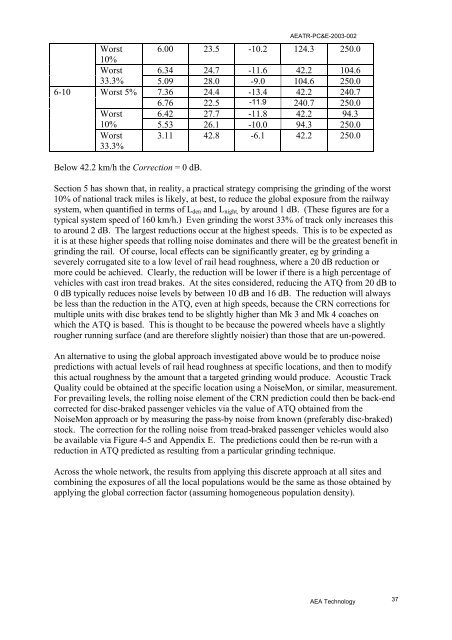Rail and wheel roughness - implications for noise ... - ARCHIVE: Defra
Rail and wheel roughness - implications for noise ... - ARCHIVE: Defra
Rail and wheel roughness - implications for noise ... - ARCHIVE: Defra
Create successful ePaper yourself
Turn your PDF publications into a flip-book with our unique Google optimized e-Paper software.
6-10<br />
AEATR-PC&E-2003-002<br />
Worst 6.00 23.5 -10.2 124.3 250.0<br />
10%<br />
Worst 6.34 24.7 -11.6 42.2 104.6<br />
33.3% 5.09 28.0 -9.0 104.6 250.0<br />
Worst 5% 7.36 24.4 -13.4 42.2 240.7<br />
6.76 22.5 -11.9 240.7 250.0<br />
Worst 6.42 27.7 -11.8 42.2 94.3<br />
10% 5.53 26.1 -10.0 94.3 250.0<br />
Worst 3.11 42.8 -6.1 42.2 250.0<br />
33.3%<br />
Below 42.2 km/h the Correction = 0 dB.<br />
Section 5 has shown that, in reality, a practical strategy comprising the grinding of the worst<br />
10% of national track miles is likely, at best, to reduce the global exposure from the railway<br />
system, when quantified in terms of L den <strong>and</strong> L night, by around 1 dB. (These figures are <strong>for</strong> a<br />
typical system speed of 160 km/h.) Even grinding the worst 33% of track only increases this<br />
to around 2 dB. The largest reductions occur at the highest speeds. This is to be expected as<br />
it is at these higher speeds that rolling <strong>noise</strong> dominates <strong>and</strong> there will be the greatest benefit in<br />
grinding the rail. Of course, local effects can be significantly greater, eg by grinding a<br />
severely corrugated site to a low level of rail head <strong>roughness</strong>, where a 20 dB reduction or<br />
more could be achieved. Clearly, the reduction will be lower if there is a high percentage of<br />
vehicles with cast iron tread brakes. At the sites considered, reducing the ATQ from 20 dB to<br />
0 dB typically reduces <strong>noise</strong> levels by between 10 dB <strong>and</strong> 16 dB. The reduction will always<br />
be less than the reduction in the ATQ, even at high speeds, because the CRN corrections <strong>for</strong><br />
multiple units with disc brakes tend to be slightly higher than Mk 3 <strong>and</strong> Mk 4 coaches on<br />
which the ATQ is based. This is thought to be because the powered <strong>wheel</strong>s have a slightly<br />
rougher running surface (<strong>and</strong> are there<strong>for</strong>e slightly noisier) than those that are un-powered.<br />
An alternative to using the global approach investigated above would be to produce <strong>noise</strong><br />
predictions with actual levels of rail head <strong>roughness</strong> at specific locations, <strong>and</strong> then to modify<br />
this actual <strong>roughness</strong> by the amount that a targeted grinding would produce. Acoustic Track<br />
Quality could be obtained at the specific location using a NoiseMon, or similar, measurement.<br />
For prevailing levels, the rolling <strong>noise</strong> element of the CRN prediction could then be back-end<br />
corrected <strong>for</strong> disc-braked passenger vehicles via the value of ATQ obtained from the<br />
NoiseMon approach or by measuring the pass-by <strong>noise</strong> from known (preferably disc-braked)<br />
stock. The correction <strong>for</strong> the rolling <strong>noise</strong> from tread-braked passenger vehicles would also<br />
be available via Figure 4-5 <strong>and</strong> Appendix E. The predictions could then be re-run with a<br />
reduction in ATQ predicted as resulting from a particular grinding technique.<br />
Across the whole network, the results from applying this discrete approach at all sites <strong>and</strong><br />
combining the exposures of all the local populations would be the same as those obtained by<br />
applying the global correction factor (assuming homogeneous population density).<br />
AEA Technology 37
















